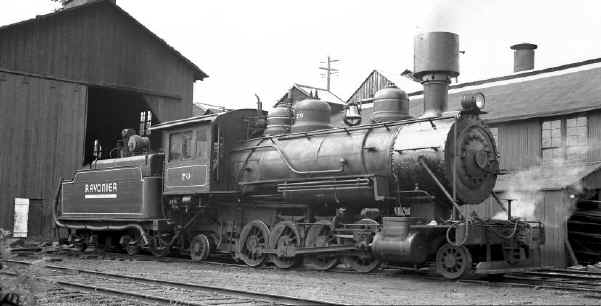Rayonier #70: Rod Locomotive |
|
By
the early 1920's the Polson Brothers Logging Co. of Hoquiam, WA had
built a large logging railroad system to provide logs to their mill in
Hoquiam.
The base of railroad operations was called Railroad Camp. Here a
roster of Shays, Climaxes and rod-type logging locomotives were
maintained to provide a steady stream of logs to the dump at New London.
As the rail system grew in size the geared engines proved too slow for
the long run to the dump.
Polson began buying rod-type engines such as 2-6-2 #45 in the
early years to speed the mainline haul.
Many of the early rod-type engines used in logging were
second-hand engines from mainline railroads of the area such the
Northern Pacific.
While powerful and fast, these mainline engines often had large
diameter tires for the gentle mainline grades. This limited the
steepness of the grades and length of train in logging applications. In
1922 Polson was in the market for a new logging locomotive to replace
some of the worn-out engines they had acquired. Baldwin Locomotive Works
was contacted for the order.
10 years earlier Baldwin had built a 70-ton 2-8-2 Mikado for the
Saginaw Timber Co. of near-by Aberdeen, WA.
Polson's master mechanic was familiar with this engine and
thought that would be just what he needed.
Polson ordered a 2-8-2 of their own as a nearly exact copy of the
Saginaw Timber engine.
This became Polson #70. The
#70 worked well when she was delivered on the mainline log-haul between
Railroad Camp and the New London Dump.
She was built with no superheating and with slide valves for ease
of maintenance.
For 20 years she was one of Polson's primary engines. In
1945 the Polson Brothers sold their logging operation to Rayonier Inc.
The first thing that Rayonier did was to expand their railroad
operations into new cutting areas even further from the log dump and to
look for even larger locomotives to haul the longer trains on the
mainline. The longer mainline trains could no longer be handled by the
70-ton #70. Since she was still in great mechanical shape and a fairly
large engine she was used on work trains and a variety of other tasks.
She served in this roll until 1963 when Rayonier sold it Rail
fan Maynard Lang bought #70 in 1963 for use at the Puget Sound &
Snoqualmie Falls RR Museum at Snoqualmie, WA. The Northern Pacific
towed #70 to Snoqualmie in 1965 and in a few years she was working at
the museum pulling work trains and tourist trains. She was used on
and off for years at Snoqualmie until the Death of Mr. Lang in 1992.
A large estate sale was held in Seattle for Mr. Lang's sizable railroad
memorabilia collection. The star of the collection was #70.
She was purchased by the Mount Rainer Scenic RR and shipped to Mineral,
WA to wait her turn in the restoration shop. #70 is scheduled to
be completed by the fall of 2003 and will be used to haul passengers. Specifications: This
70-ton Rod Engine was built by the Baldwin Locomotive Works of
Philadelphia, PA. for the Polson Brothers Logging Company of Hoquiam,
WA:
Ownership
History:
Photographs and information courtesy of Martin E. Hansen |
| HOME | ||||
| Cams/Plating |
